The fashion industry has firmly established its position in the human mind, even the most disinterested people imperceptibly succumb to all the trends of street, office or other style. Trousers are one of the most important attributes of the chosen image, and how to sew trousers for many needlewomen is not a difficult task. Often, many cannot find what they like in boutiques and stores, so they have to sew trousers themselves. A pregnant woman cannot always choose a fashionable classic version of trousers for herself, a wide enough style or a suitable size, because of this, she has to resort to self-sewing.
- How to choose a style
- Straight cut
- Tapered or flared
- Low waistline
- Regular fit or high waist
- Choice of fabric
- Flax
- Viscose
- Chambray
- Gabardine (wool, artificial)
- Drawings
- Italian method
- According to Muller
- Necessary measurements and rules for taking them
- Necessary measurements for sewing trousers:
- Operating procedure
- DIY sewing
- Bananas
- For pregnant women
- Insulated with synthetic padding
- In oriental style with elastic band
- Home pants without a pattern
- Palazzo pants, joggers and cigarettes.
How to choose a style
To fully understand how to sew perfect trousers, emphasizing all the advantages and hiding the disadvantages, it is enough to know and correctly evaluate all the features of the body and which lines predominate in it - linear or rounded.
Straight cut
This type of trousers will suit both male and female figures. If the waist is significantly smaller than the hips (by 15-25 cm), slender legs or narrow athletic hips, then the straight cut model will perfectly emphasize all the advantages of this body type.
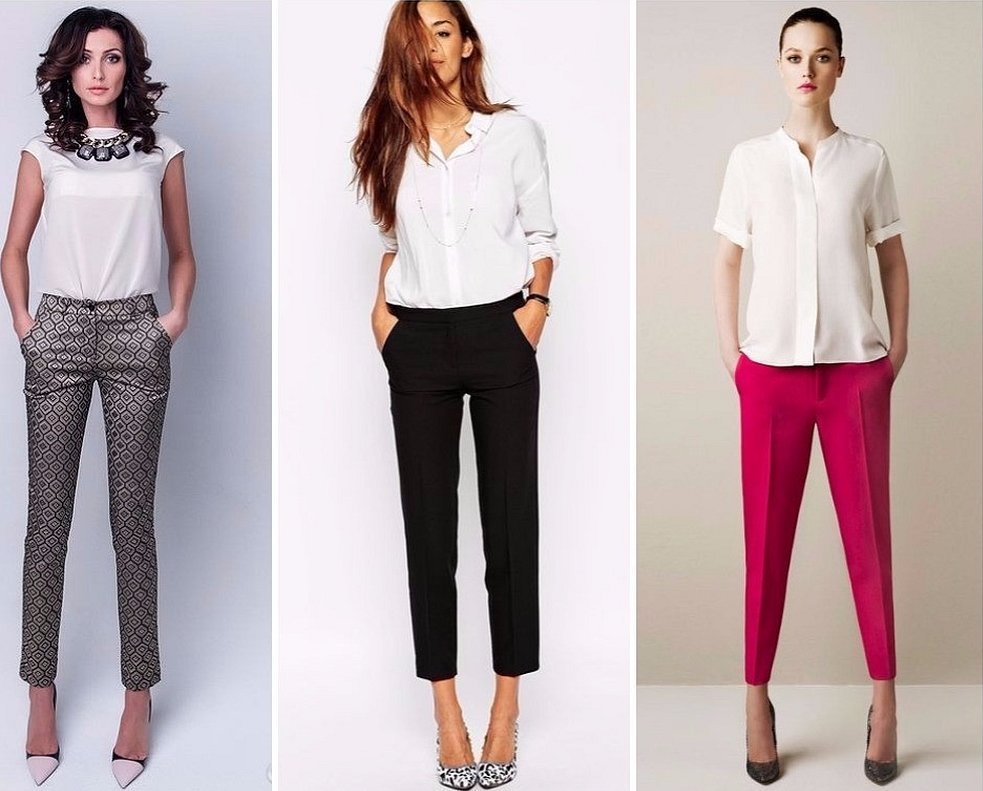
Tapered or flared
If the transition from the waist to the hips is noticeable (if the difference is more than 25-30 cm) and they are round, it is best to wear flared or tapered trousers.
Please note! If the waist is too wide, then harem pants or wide trousers with a flare coming down from the waist are absolutely not suitable - this will visually increase the figure to enormous dimensions.
Low waistline
Low-waisted trousers are suitable for girls with an unnoticeable transition from the waist to the hips. The trousers should be complemented with wide and voluminous pockets or bright embroidery, drapery - such additional elements will allow you to create visible volume of an elegant waist.

Regular fit or high waist
If your hips are very wide and stand out against the rest of your figure, then you should take a closer look at trousers that do not emphasize all the unnecessary details and bulges. Stylish flared trousers from the knee with a classic fit are perfect for this type of figure, you should avoid various decorative decor on the hips, it can visually widen the already rather large hips.
Choice of fabric
Before choosing the right fabric, it is worth deciding what kind of trousers it will be used for: everyday wear or festive and weekend wear. And in what season, in what weather: cold winter, hot summer, cool autumn or uncertain spring.
Fabrics are divided into two types:
- Summer - most often these are natural materials, since in hot weather artificial textiles do not wick away moisture and do not allow the skin to “breathe”, which can lead to overheating of the body.
- Winter - the requirements for such fabrics are the same, to retain heat well. In this case, both artificial and natural materials are suitable.
Flax
Distinctive properties:
- Does not become electrified;
- Does not require special care;
- The fabric is natural and environmentally friendly;
- Conducts heat well;
- The material contains silica, which prevents the development of a number of bacteria while wearing clothes made from this material;
- Long service life.
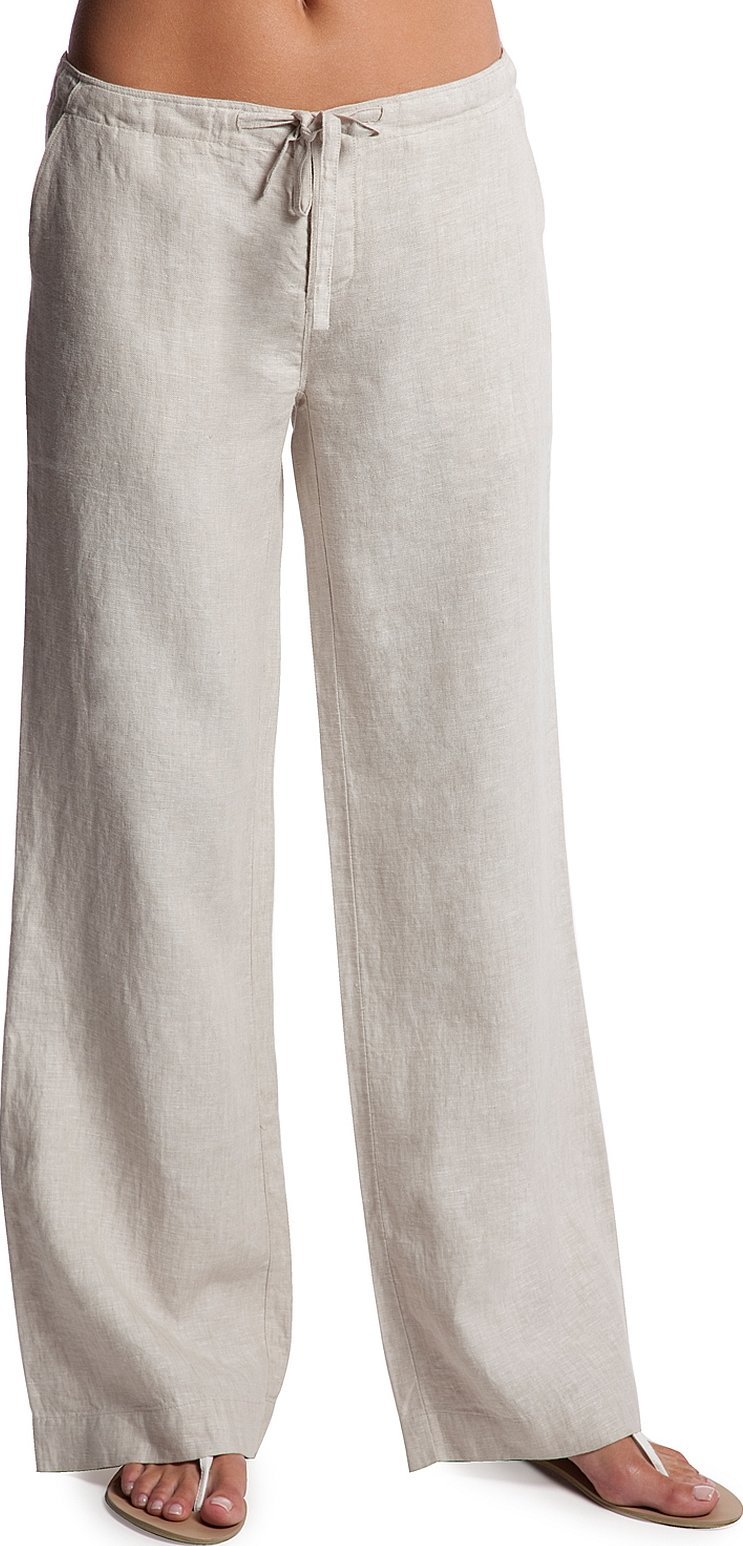
Trousers made of linen fabric are distinguished by their simple, comfortable and easy wearing. Due to different processing techniques, the fabric can be both dense and light, but it does not lose its breathability in any case. An excellent summer option for clothing made of natural material.
Additional information! For business suits, where a denser fabric is required, flax thread from waste is used.
Viscose
Distinctive properties:
- Absorbs moisture well;
- Lightweight and breathable fabric;
- Hypoallergenic;
- Soft and delicate texture;
- Easy to wash;
- Holds color perfectly, even after numerous washes.

A budget fabric option with excellent performance characteristics. Wear resistance, comfortable to wear, fits nicely to the body - a great option for everyday use in the summer or spring.
Chambray
Distinctive properties:
- Wear-resistant;
- Despite its density, the fabric is quite light;
- Hygroscopic and breathable;
- Does not become electrified;
- Does not wrinkle;
- Easy to wash, withstands spinning well.
The material belongs to the group of denim fabrics. The structure is somewhat similar to cambric. This fabric is demi-season and is suitable for sewing trousers for any weather. Sewing trousers from this material will not cause difficulties, even the most inexperienced craftsman can easily cut out any model thanks to its texture, suitable for any type of figure.
Gabardine (wool, artificial)
Distinctive properties:
- Long service life;
- Lightweight and pleasant to the touch fabric;
- Moisture-resistant and wrinkle-resistant material;
- Draped.
This material has a twill weave. It is perfect for sewing winter pants, the material retains heat well. Ironing is allowed only with steam, do not iron too hard, this can contribute to the fabric becoming shiny.
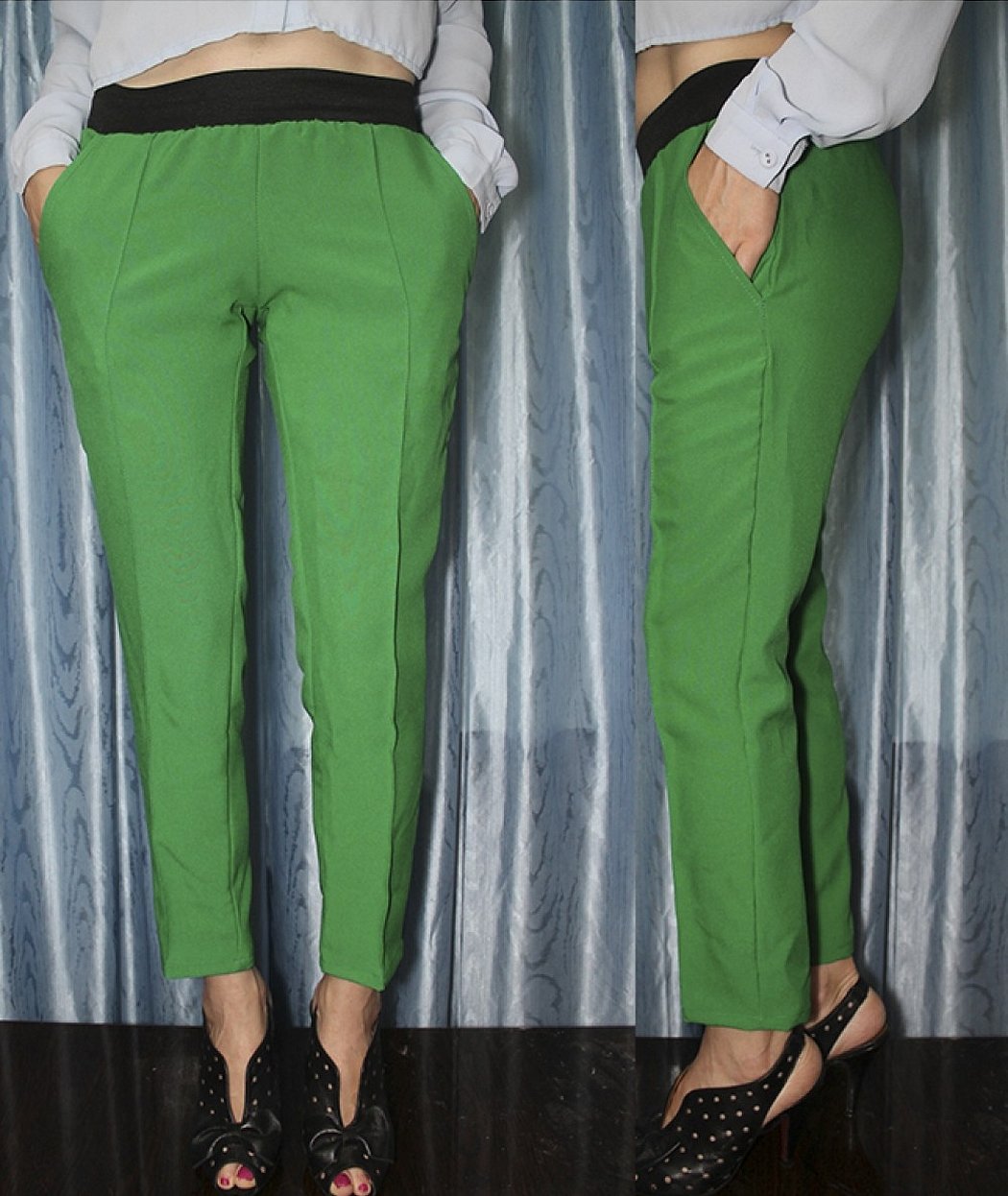
The choice of fabrics should be approached quite responsibly. It is worth considering not only the external characteristics, but also the distinctive properties. For sewing, you can also use satin, corduroy or velvet, these materials never go out of fashion.
Drawings
There are several methods for creating patterns.
Italian method
This technique of constructing trousers is mainly applicable to women with a fairly large bend in the back area, at the base of the waist. These trousers have an excellent fit at the hips and waist.
To make a pattern, you should take measurements: around the hips and waist, hip height, rise height, height from the knee, knee circumference, main length from heel to waist.

According to Muller
The construction of the pattern scheme according to Müller is one of the simplest and most suitable for beginners. Also in this pattern the concept of a step seam is used, which greatly simplifies sewing and makes the product more accurate in size.
Measurements are taken according to the following data: waist and hip circumference, seat height, side length, width of the bottom of the trousers, step size.
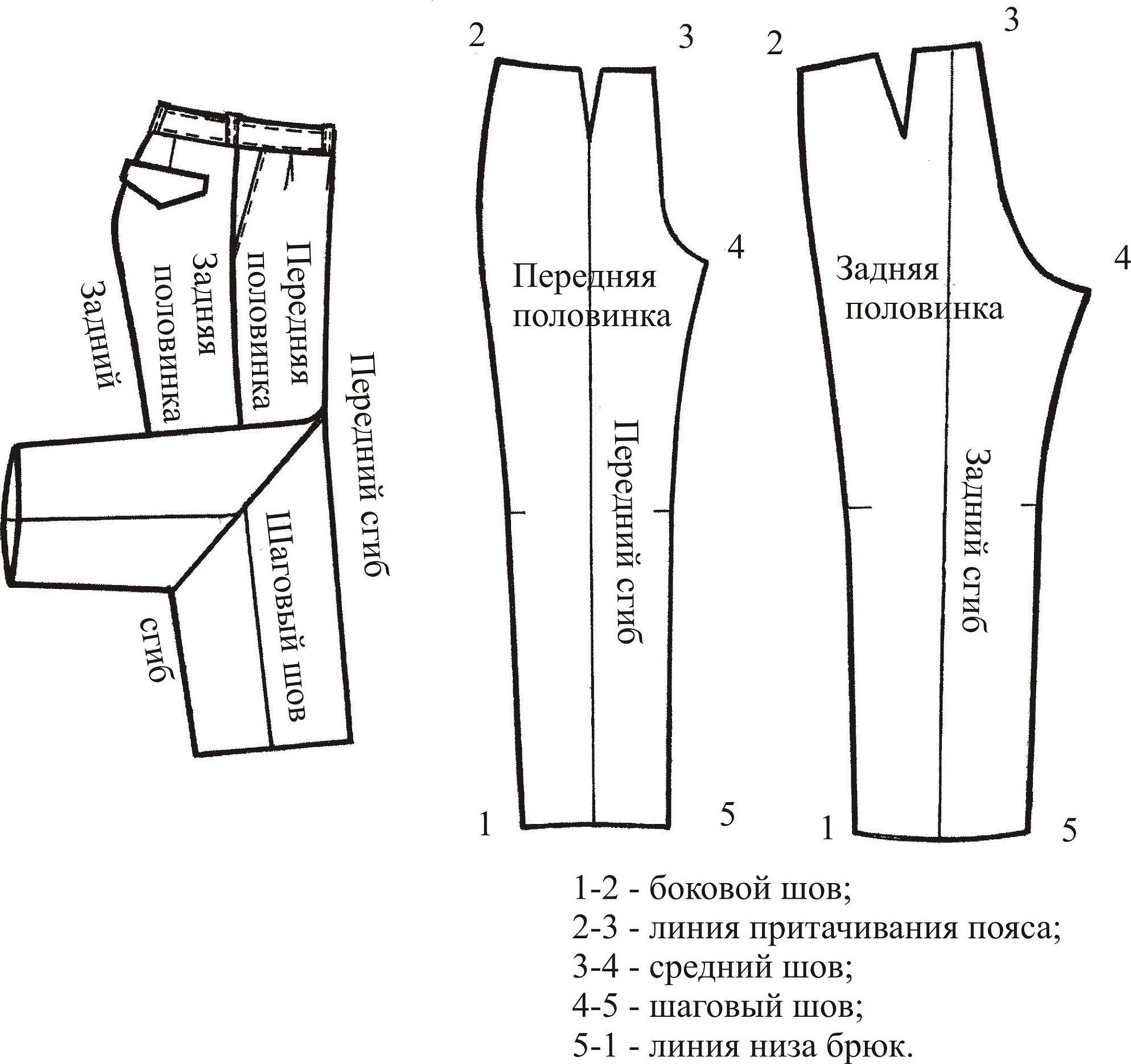
Necessary measurements and rules for taking them
Basic rules for taking measurements correctly:
- The measurement should be taken from a person wearing tight-fitting clothing or underwear that is intended to be worn with the item that needs to be sewn.
- The waist should be marked with a belt or ribbon.
- When taking measurements, a person should stand straight, relaxed and in a pose that is familiar to him, so that his posture is in a natural position.
- The measuring tape should fit tightly to the person's body, in no case should it squeeze it, and especially should not be lowered.
- The measurement is taken on the right side, where the body is most developed; if the person is left-handed, then the same is done on the left.
Necessary measurements for sewing trousers:
Half waist circumference (W) - the measurement is taken at the narrowest point of the waist, the centimeter is taken strictly along the horizontal part of the waist (to record, divide the data by 2).
Half hip circumference (H) - the measurement is taken at the most prominent points on the hips, horizontally (to record, divide the data by 2).
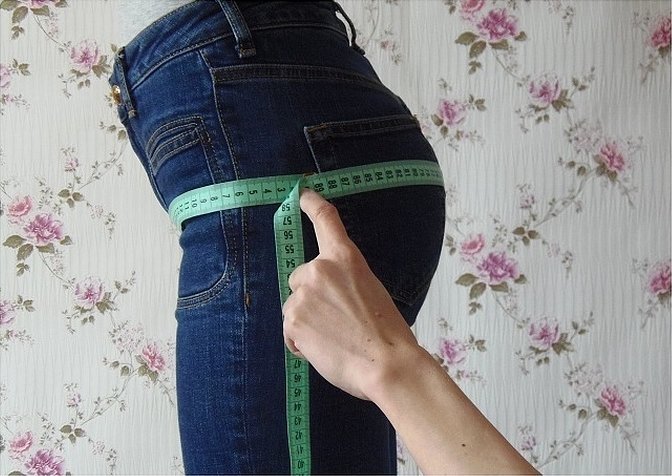
Trouser length - measurement is taken from the waist to the heel along the side line (recorded in full).
Length of trousers to the kneecap (LTK) - the measurement is taken from the waistline to the middle of the knee (the full number is recorded).
Knee circumference (OK) — the knee circumference is measured with a seated person with the leg bent at 90 degrees. For trousers that should fit tightly, the measurement is taken with the leg straight (the measurement is recorded in full).
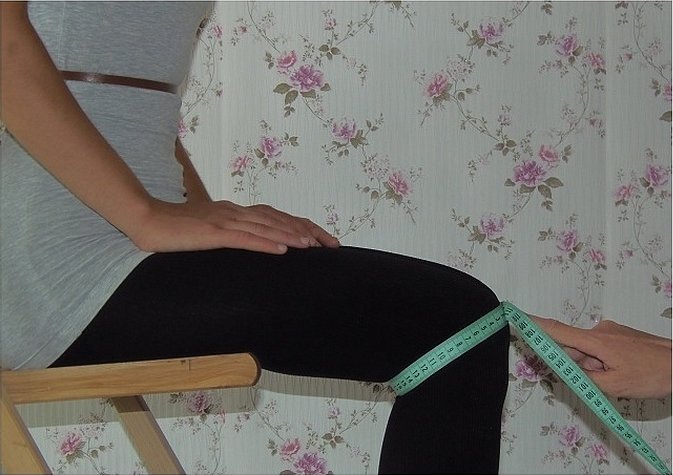
Hip circumference - measurement is taken at the widest part of the top of the leg (the measurement is recorded in full).
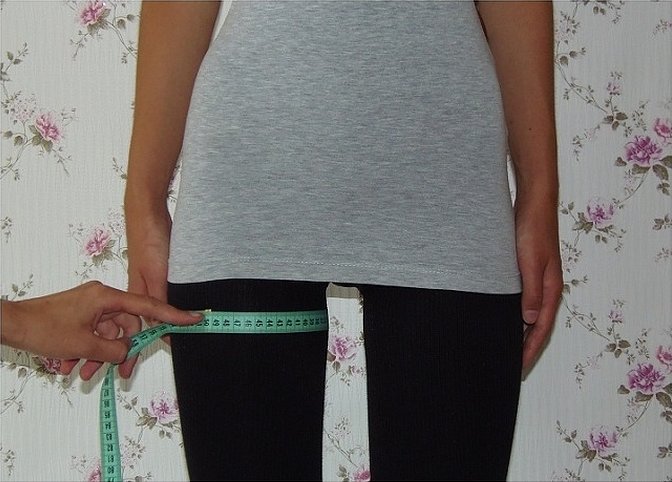
Calf circumference (CG) - the measurement is taken at the widest part of the leg below the knee, on the calf muscles (the measurement is recorded in full).
Ankle circumference (AC) - measurement is taken under the inner part of the ankle, horizontally (the measurement is recorded in full).

Groin length (GL) - from the waist on the back side, through the groin, to the front side of the waist line (the measurement is recorded in full).
Seat Height (SH) - Measurements are taken from a seated position on a chair, from the waist line to the seat of the chair (the measurement is recorded in full).
Operating procedure
After choosing the fabric, taking measurements and preparing the necessary attributes, we sew women's trousers following the step-by-step lesson.
- The trousers are cut out according to the measurements taken. Initially, the main parts are laid out on the fabric, and only then are additional small parts placed in the remaining gaps.
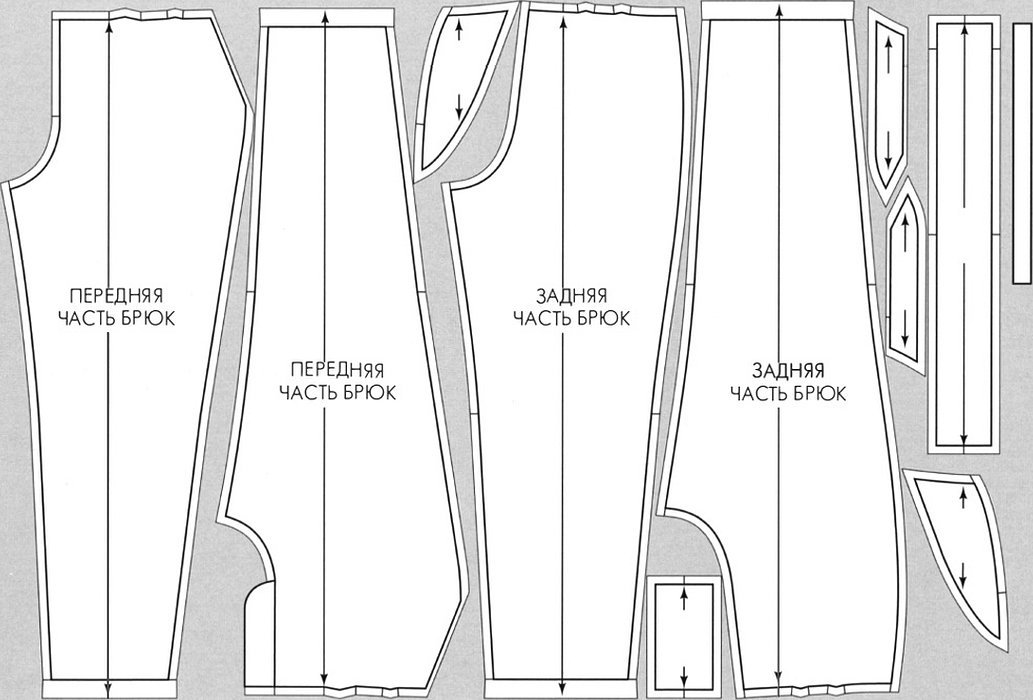
- A seam allowance is made from each outlined piece.
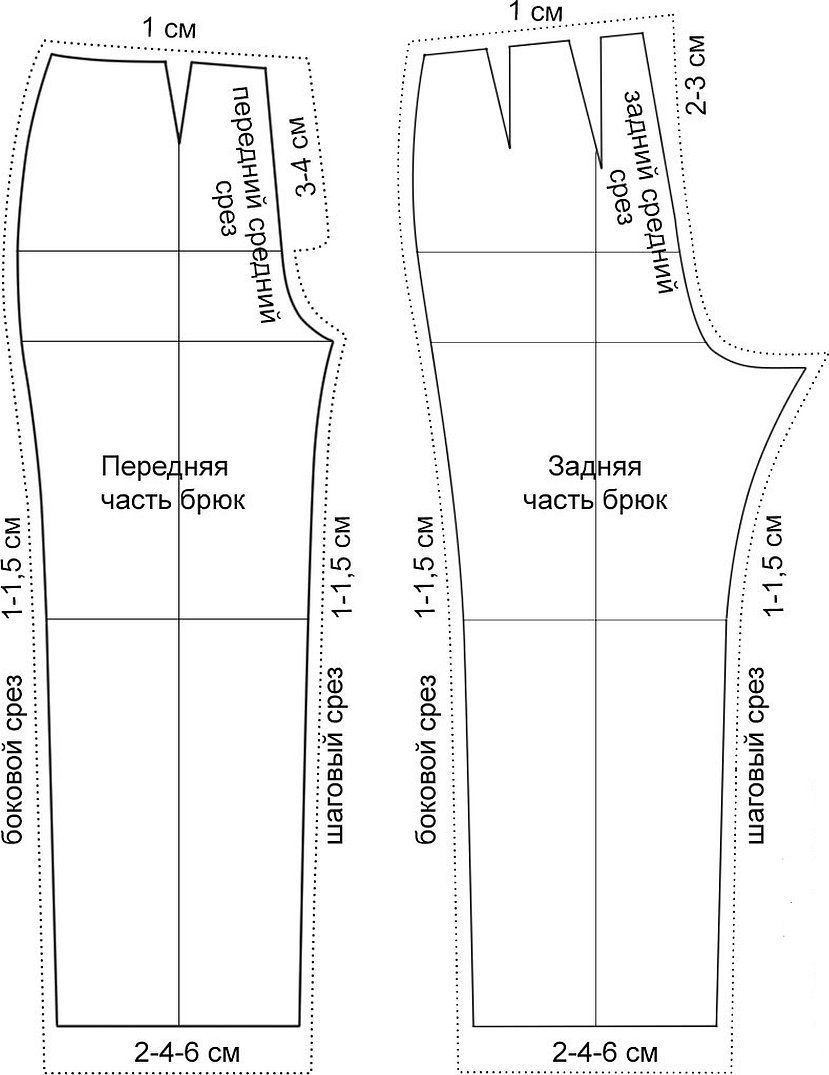
- Afterwards, all the details are cut out, the edges are processed and the time comes to sew all the pieces together.
Sequence of sewing trousers:
- Before you start, you should mark where the pockets will be;
- Heat treatment;
- Sweep the trousers along the lines and try them on before sewing;
- Pockets and darts should be finished;
- Zipper processing and sewing.
- Processing of cuts (step and side);
- The middle sections need to be filed down;
- Final ironing of the product.
DIY sewing
Below we will look at sewing different types of trousers.
Bananas
Master class on sewing banana-style pants.
Pattern:
- Front and back halves of trousers - 2 pieces each;
- Side cut-off, one-piece with a pocket - 2 pieces;
- Pocket burlap - 2 pieces;
- Waist part - 4 pieces;
- Belt loops - 6 pieces, width at your discretion, on average 3-5 cm, and length 7-9 cm.
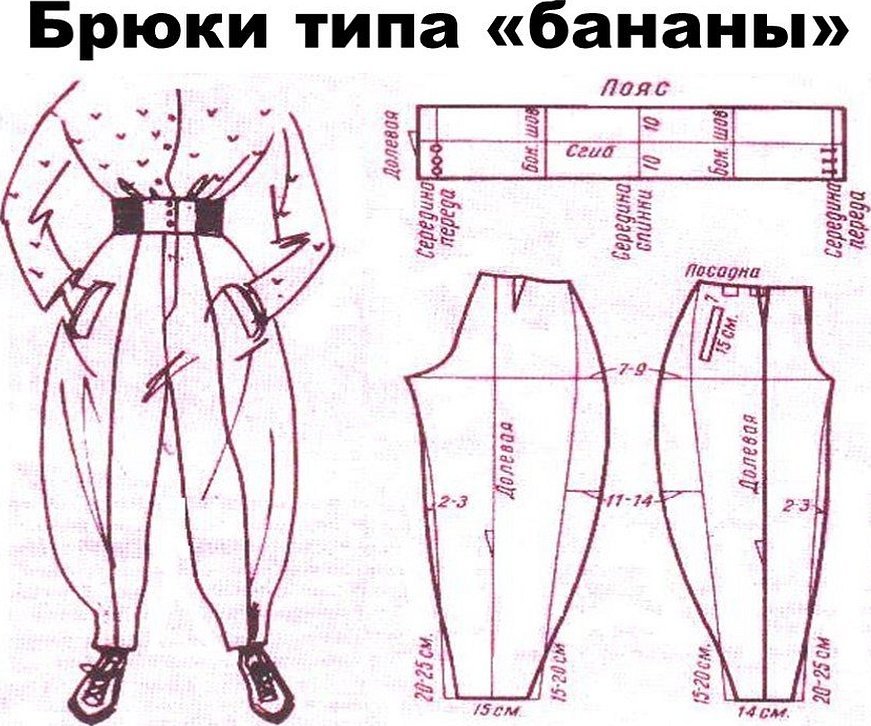
Sewing bananas using the patterns made:
- On the front part you should make a pocket with a cut side.
- On the back part, you need to baste and stitch the dart. Iron everything to the middle seam along the back of the trousers.
- Do the same with the side and inner seams, and the middle seam to the hem.
- Sew in a zipper.
- Reinforce the belt with thermal fabric.
- Sew in a belt.
- Turn up the bottom of the trousers and baste them by hand with a blind stitch.
- Sew belt loops onto the trouser waistband.
At your discretion, the belt can be made either high or low.
For pregnant women
We sew women's trousers for pregnant women with a knitted insert in the front. This wide insert is the key point in sewing this type of trousers. You can also model the insert based on the selected fabric and affecting only the front part of the trousers: draw a circle along the lines of the side seam, stepping back 5-6 cm from it.
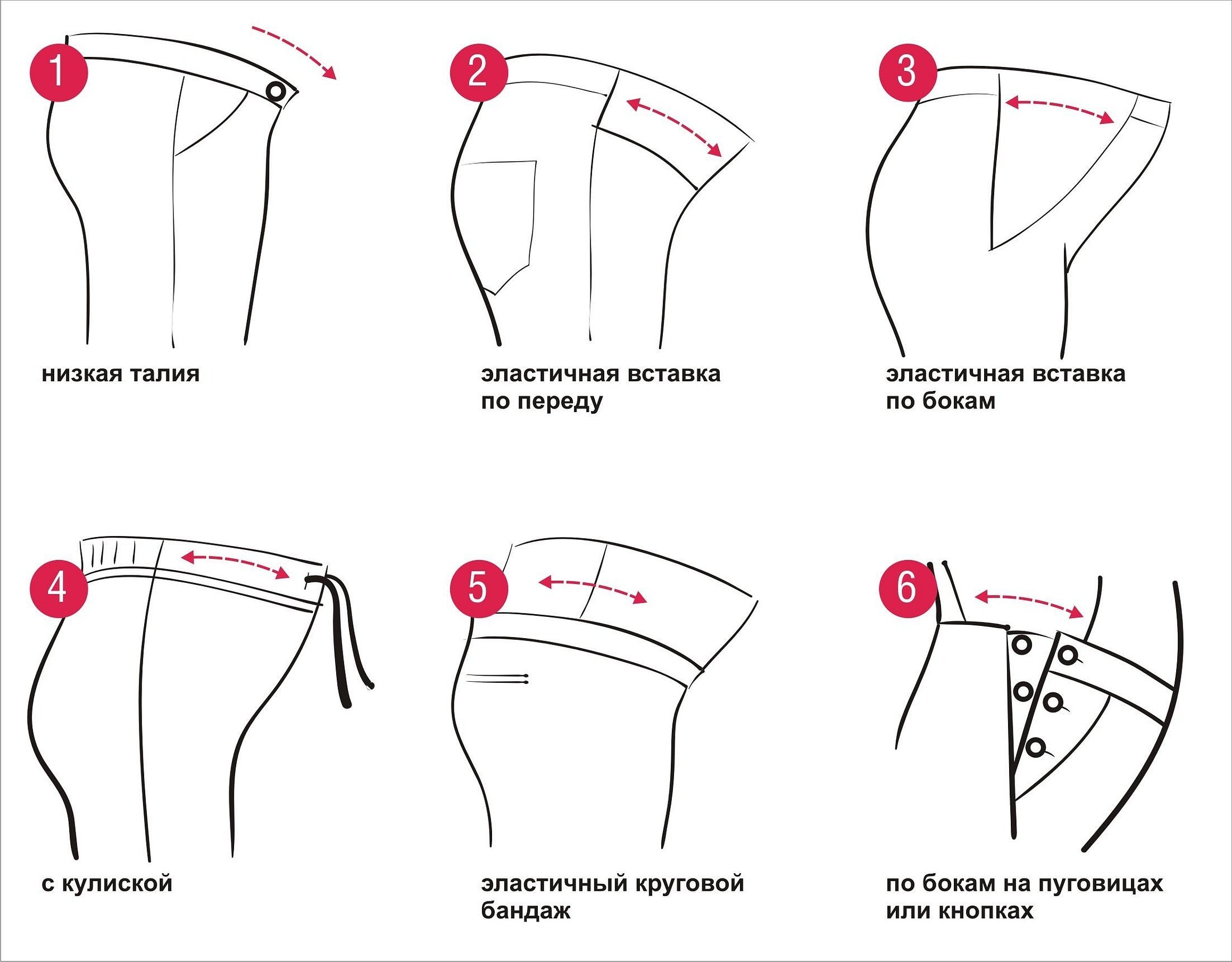
The place where the crotch seams lose their curve and become a straight line is at the bottom line or at the insertion point of the knitwear.
- It is also worth thinking about the location of the zipper in advance, if you need it.
- It is worth choosing a fabric with a small amount of elastin, so it will not stretch too much and will retain its shape as your belly grows.
- It is better to grind elastine 4 times for winter wear, and 2 times for summer wear.
Insulated with synthetic padding
The pattern according to Müller described earlier is used, only an additional lining based on synthetic padding or piping is added, a wide elastic waistband is sewn in and cuffs are placed on the bottom of the pants.
In oriental style with elastic band
We sew women's trousers in the oriental style. When purchasing fabric, you should make sure that it is long enough, it should correspond to the parameters of the length of the trousers. For harem pants or Aladdins, it is best to choose flowing fabric. Bright accessories for decorating trousers are also acceptable.
The pattern for oriental pants is shown in the picture below.
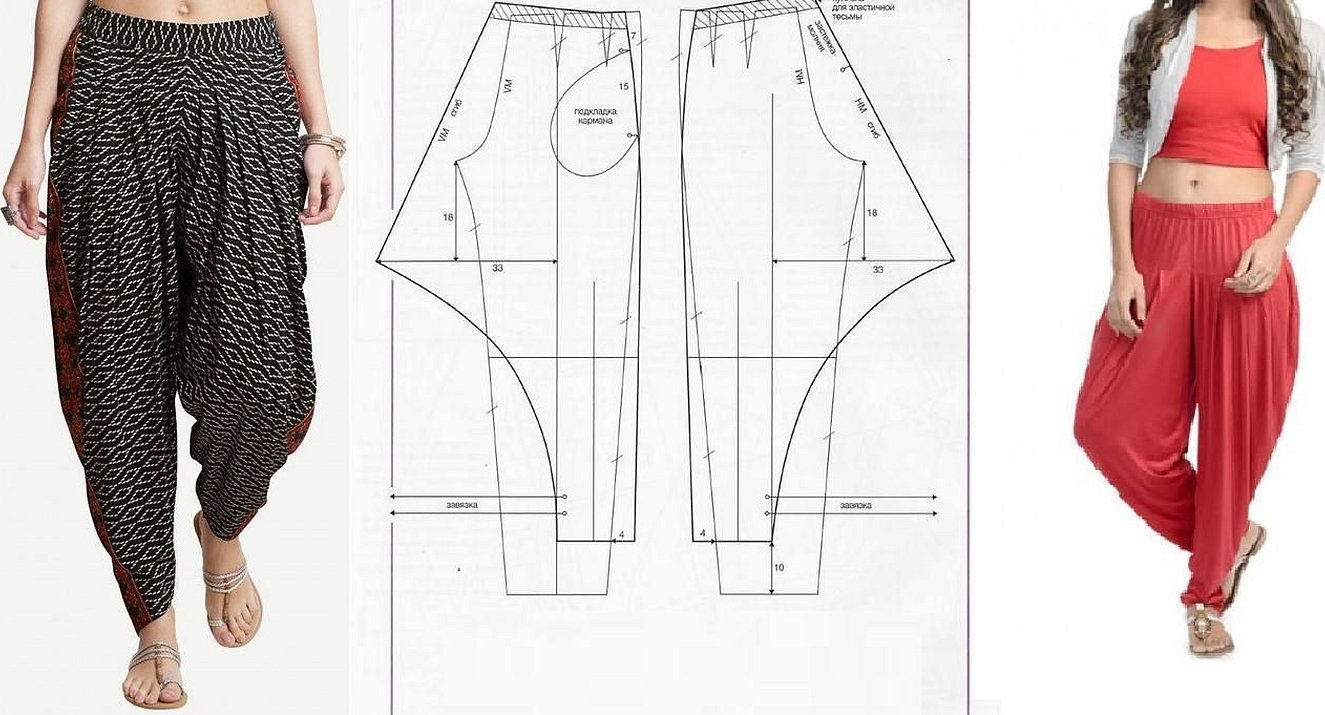
The measurements and stitching are similar to the banana pants pattern.
Home pants without a pattern
A large number of options for cutting trousers without a pattern and drawings for beginners are stored on the Internet, one of the simple methods is described below.
Required measurements:
- Hip and waist circumference (before recording, the figure should be increased by 6-8 cm);
- Full length from waist to heel;
- Saddle length;
- Groin measurement.
- Ankles and knees are recorded as 18 and 21 cm respectively, regardless of other dimensions.
Important! If you want a looser fit of trousers, you should make wider allowances.
After measuring, it is worth transferring all the data to the back of the fabric using tailor's chalk and cutting out all the details. After sewing, you need to decide on the belt - it can be a drawstring or elastic. If elastic, then it should be pulled in before sewing the base.
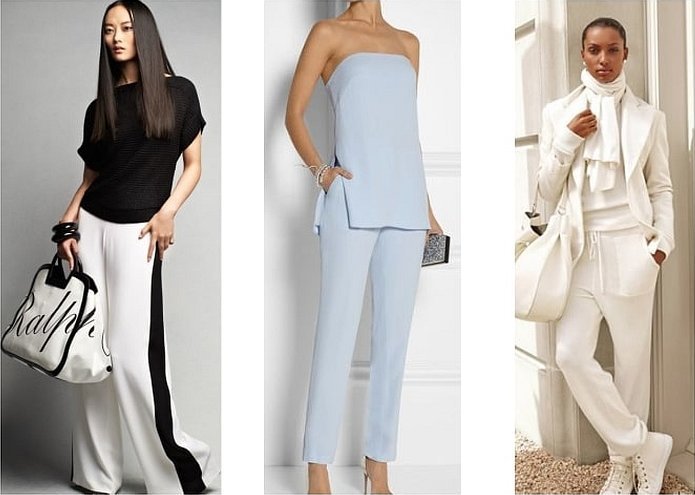
Palazzo pants, joggers and cigarettes.
Palazzo skirts themselves resemble culottes since the flare goes directly from the hip. Sewing is done according to the Italian method, the pattern is provided in the picture below.
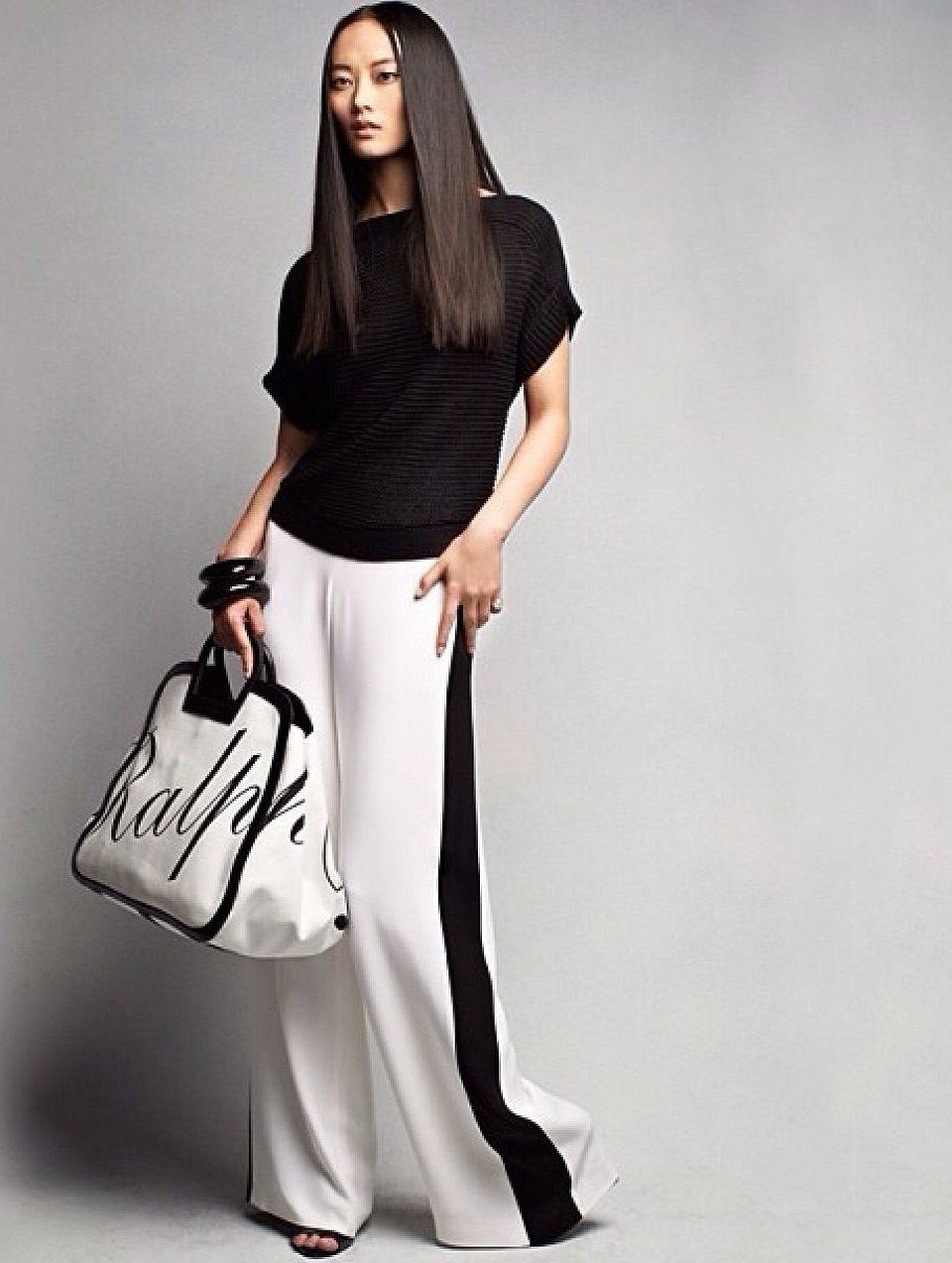
Joggers are comfortable trousers for everyday wear, low rise, tightly fitting at the hips and not too tapered towards the ankle. Sewing is done using the Muller technique. The pattern is provided in the picture below.

Cigarette pants favorably emphasize female sexuality. And the straight cut goes well with jackets and blouses. These pants can be sewn both according to Muller's drawings and the Italian method. The pattern is presented below.
Sewing beautiful trousers of women's styles does not take much time. These patterns can be used for sewing children's pants for both boys and girls. A share of old things can also be suitable for a quick pattern of home pants. Careful selection of fabrics guarantees long wear. Today, especially in Moscow, classic types of trousers are popular. Wool and cotton trousers, diluted with lace, will look very impressive and original at the waist. Synthetic fabrics, for example viscose, stretch perfectly, which will allow the trousers to sit perfectly on any figure. And classic linen is great for everyday use, the only drawback is that it wrinkles easily. But all its advantages outweigh this trifle.




